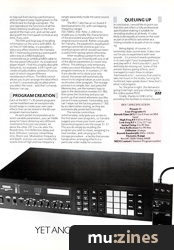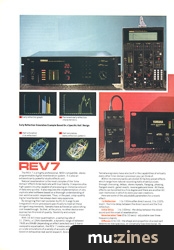Magazine Archive
Home -> Magazines -> Issues -> Articles in this issue -> View
Yamaha REV-7 Digital Reverberator | |
Yet Another MilestoneArticle from Sound On Sound, November 1985 | |
Low cost digital reverb comes of age according to Producer Robin Lumley.
The term 'studio quality' often infers a studio price tag but that's certainly not the case with this affordable digital reverb from Yamaha. Record producer/ musician Robin Lumley was so impressed with the host of facilities it offered that he was moved to put pen to paper...

I had recently begun to think that the term user-friendly had been overworked and quite often misapplied in the case of most hard and software musical and computer-related equipment on the market today. Yet, searching through both the operations manual and the glossy brochure accompanying this new digital reverb unit from Yamaha, I can find no trace of the phrase. But if ever a unit deserved to be dubbed user-friendly, this is it.
The REV 7 has obviously absorbed an inordinate amount of careful thought and research time in its pre-production phase, with a heavy dose of effort being spent on who is eventually going to use and operate it.
The asking price of the unit is quite absurd in value for money terms, being only £1040 plus VAT; and I mean absurdly low! Can't see many retailers offering discounts on this one. You'll see what I mean if you read on...
OPERATIONAL FEATURES
It's a high quality reverberation unit essentially, suitable for studio or stage use. The format is standard 19" rack-mountable, with the make-it-go buttons on the front panel, and the plug-it-in-to-something holes on the back.
So far, so normal. But the number and permutations of the ways it provides reverb effects is certainly not normal. It does almost everything imaginable (and sometimes unimaginable) to an input signal in terms of reverb, echo, phase and flange, and in such an easy, clean and accessible manner that you'll wonder how you ever did without one. At this point, you may have gathered that this is a somewhat favourable review, but it's hard to exclude superlatives whilst writing about the REV 7. You only have to hear one to appreciate why.
When a signal is sent into the REV 7 reverberator via the balanced jacks or XLRs, it is first EQ'd, then metered, then passed into an Analogue to Digital converter. Any stereo input is mixed to mono prior to being processed into a reverb signal. However, the direct, or source signal, remains in stereo. The effect is then created within the Digital Signal Processor, which is the very heart of the unit.
The processed signal is then converted back into a stereo format reverb signal (regardless of whether or not it started life in mono) by two Digital to Analogue converters, which create two slightly different Left and Right reverberation patterns. This analogue end result is then mixed with the direct signal using the mixer control.
When I referred to effect just now, I should, of course, have said effects because before you even have to start dreaming anything up, there are already 30 various built-in presets in the memory for you to use. In addition, memories 31 to 90, the user programs, are there for you to invent and store your own reverb creations. With a back-up lithium 5-year battery on board, there's no chance either that anything of yours is dumped when the mains is off. The presets (1 to 30) are unaffected anyway.
USER-FRIENDLY
Enter that well-worn phrase again. The front panel of the REV 7 is a doddle (if you'll pardon the vernacular) to understand. Even I figured it all out in under five minutes, and I usually have trouble opening a tin of baked beans!
Direct Recall buttons permit instant access to all 30 presets, as well as the first seven user programs. These 30 presets, by the way, cover a vast range of possible effects... various size halls, simulations of mechanical reverb devices, recording studio-type acoustic environments, stereo delays, and a range of flange/phase modulation effects. And if there is nothing there that is exactly what you want to hear, it's easy to programme something of your own.
RECALL
There are five ways of recalling information from the unit:
1. Direct Recall. Presets 1-30 and programs 31-37 appear at the touch of the number-buttons and a liquid crystal display tells you what you've recalled.
2. Numeric Recall. Press the Memory key, and then the numeric key to select programs 1-90. The advantage here is that the same operation is required for all programs, preset or self-created.
3. +/- Key Recall. This method allows you to 'scroll' through all 90 programs, which is very helpful if you're searching for something soundwise and you can't remember where in the banks you've parked it. Simply press the Memory key, and then the + key to step through the programs in an upward direction numerically, or press the - key to come back down again. Quite logical.
4. Remote Recall. Each REV 7 comes, at no extra cost, with a small hand-held remote control box. This is very useful for a keyboard player or guitarist who wants to stay out front during a performance, and not have to keep nipping back to the effects rack to change a program. The unit reproduces the functions of all the Direct memory recall keys on the front panel of the main unit, and can be used along with the front panel controls at any time, if you wish.
The fifth and final way of recalling information on the unit is with MIDI. As on their D1500 delay, it is possible to select any effect stored in the Yamaha REV 7 memory by pressing a voice/patch select key on a MIDI keyboard, connected via an umbilical MIDI cable to the rear panel DIN socket. As a keyboard player myself, I find this a highly desirable feature as, for example, a DX7 synth can create virtually endless varieties of voices, each of which require different reverberation effects. The MIDI control allows you to pre-arrange the ideal effect so that it's automatically recalled when you select the voice - and that's a handy feature I can say.
PROGRAM CREATION
Each of the REV 7's 30 preset programs can be modified over an exceptionally broad range to create your own new effects that can be stored in the 60 user program memory banks.
As each preset incorporates up to seven variable parameters, you can fiddle away for hours obtaining very different treatments from just one preset, let alone the other 29! You can alter the Reverb time, First Reflection delay and level, Diffusion, Liveness, Initial Delay time, Room size, Modulation frequency and depth, and you can even modify the reverb time of high and low frequency ranges separately inside the same source signal.
The REV 7 also has an on-board 3-band parametric EQ, with overlapping frequency ranges (50-700Hz; 350-7kHz; 2-20kHz) to enable you to modify the characteristics of the processed sound (but not the original source sound). Rather unusually for Yamaha, the parametric equalisation settings cannot be stored as part of a reverb program which would have been a useful time-saving option otherwise.
After recalling a preset from the memory, you can instantly edit any or all of the above parameters to create new effects. This editing is only temporary unless you store the data into the user program memory ie. in numbers 31-90.
If you decide not to store your new sound, the preset will automatically return to its original values as soon as you recall some other program. The storage process is so simple, too. Just press the Memory key, use the numeric keys to type in the destination number (31-90), then press the Store key and you can punch up that sound whenever you like, just as if it was a preset. Fortunately, you can't wipe out the factory presets (1-30) by accident when storing, as they are automatically protected internally.
The remote control box, unfortunately, only gives you access to the first seven user programs, so Yamaha suggest you move your most-used or favourite programs into the range 31-37. This you do simply by recalling the program you wish to move, assigning it a new number, and carrying out the storage procedure - a facility that proves handy when arranging effects in a particular order ready for a session.
QUEUING UP
REV 7 SPECIFICATION
| Presets | 30 |
| User Programs | 60 |
| Reverb Time (RT) | 0.3 to 9.9 sec on Mid band |
| High Freq RT | 0.03 to 9.9 sec |
| Low Freq RT | 0.12 to 23.7 sec |
| Initial Delay | 0 to 99.9ms |
| First Reflection | 0 to 99.9ms |
| Diffusion | 10 steps |
| Reverb Bandwidth | 20Hz-12kHz |
| Dynamic Range Reverb: | 78dB / Delay: 84dB |
| MIDI Control | Channel/Program number |
In conclusion, I would like to point out that this unit offers a fully professional specification making it suitable for recording studios at all levels. It's also likely to be equally at home on the road as part of an effects rack either at a mixing console or as part of an on-stage rig.
Being digital, of course, it's extremely clean sound-wise. It also cries out for you to experiment with new sounds... it's a kind of reverb synthesizer in its own right if you're prepared to sit and play with it. And if you don't, you'll definitely be missing out. Some of the presets feature gating effects, and I managed to invert these to obtain 'backwards echo', a process that used to take me hours in the studio, turning the multitrack tape upside down! Now that's what I call progress.
So, the price is right, the demand is going to be high, and you'd better get in the orders queue PDQ!
Finally, thanks to HHB Ltd for providing the facilities to review this unit.
Also featuring gear in this article
Roland SRV2000 & Yamaha REV7 Reverbs
(12T Feb 86)
Wide Open Spaces
(EMM Sep 85)
Yamaha REV-7 - Studio Test
(IM Oct 85)
Yamaha REV7 - Digital Reverb
(HSR Oct 85)
Browse category: Studio/Rack FX > Yamaha
Featuring related gear
All Revved Up
(HSR Mar 86)
Interior Designs - Yamaha REV5 Reverb
(SOS Nov 87)
Browse category: Studio/Rack FX > Yamaha
Publisher: Sound On Sound - SOS Publications Ltd.
The contents of this magazine are re-published here with the kind permission of SOS Publications Ltd.
The current copyright owner/s of this content may differ from the originally published copyright notice.
More details on copyright ownership...
Review by Robin Lumley
Previous article in this issue:
Next article in this issue:
Help Support The Things You Love
mu:zines is the result of thousands of hours of effort, and will require many thousands more going forward to reach our goals of getting all this content online.
If you value this resource, you can support this project - it really helps!
Donations for April 2024
Issues donated this month: 0
New issues that have been donated or scanned for us this month.
Funds donated this month: £7.00
All donations and support are gratefully appreciated - thank you.
Magazines Needed - Can You Help?
Do you have any of these magazine issues?
If so, and you can donate, lend or scan them to help complete our archive, please get in touch via the Contribute page - thanks!












